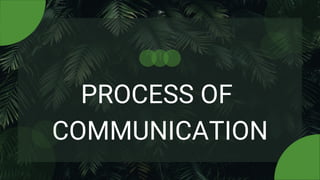PROCESS OF COMMUNICATING
•
0 likes•10 views
The communication process involves several steps: (1) idea formation where the sender clarifies the message purpose, (2) encoding the idea into words and symbols that are commonly understood, (3) transmitting the message verbally, visually, or in writing, (4) decoding the message as intended by the sender to avoid misunderstandings, and (5) providing feedback to ensure the message was understood correctly. Successful communication requires matching the medium to the message, awareness of the receiver's skills and experiences, and clear feedback between the sender and receiver.
Report
Share
Report
Share
Download to read offline

Recommended
Recommended
More Related Content
Similar to PROCESS OF COMMUNICATING
Similar to PROCESS OF COMMUNICATING (20)
Process of communication || Communication Skills || By Dr. Anukriti Sharma

Process of communication || Communication Skills || By Dr. Anukriti Sharma
communication.pptx for nursig student to better acheivement

communication.pptx for nursig student to better acheivement
1. intro, importance, purpose of communication, process, and 7c's.pptx

1. intro, importance, purpose of communication, process, and 7c's.pptx
Recently uploaded
https://app.box.com/s/4hfk1xwgxnova7f4dm37birdzflj806wGIÁO ÁN DẠY THÊM (KẾ HOẠCH BÀI BUỔI 2) - TIẾNG ANH 8 GLOBAL SUCCESS (2 CỘT) N...

GIÁO ÁN DẠY THÊM (KẾ HOẠCH BÀI BUỔI 2) - TIẾNG ANH 8 GLOBAL SUCCESS (2 CỘT) N...Nguyen Thanh Tu Collection
This presentation was provided by William Mattingly of the Smithsonian Institution, during the closing segment of the NISO training series "AI & Prompt Design." Session Eight: Limitations and Potential Solutions, was held on May 23, 2024.Mattingly "AI & Prompt Design: Limitations and Solutions with LLMs"

Mattingly "AI & Prompt Design: Limitations and Solutions with LLMs"National Information Standards Organization (NISO)
Recently uploaded (20)
Salient features of Environment protection Act 1986.pptx

Salient features of Environment protection Act 1986.pptx
Students, digital devices and success - Andreas Schleicher - 27 May 2024..pptx

Students, digital devices and success - Andreas Schleicher - 27 May 2024..pptx
Basic phrases for greeting and assisting costumers

Basic phrases for greeting and assisting costumers
Basic Civil Engg Notes_Chapter-6_Environment Pollution & Engineering

Basic Civil Engg Notes_Chapter-6_Environment Pollution & Engineering
MARUTI SUZUKI- A Successful Joint Venture in India.pptx

MARUTI SUZUKI- A Successful Joint Venture in India.pptx
Basic Civil Engineering Notes of Chapter-6, Topic- Ecosystem, Biodiversity G...

Basic Civil Engineering Notes of Chapter-6, Topic- Ecosystem, Biodiversity G...
aaaaaaaaaaaaaaaaaaaaaaaaaaaaaaaaaaaaaaaaaaaaaaaaaaaaaaa

aaaaaaaaaaaaaaaaaaaaaaaaaaaaaaaaaaaaaaaaaaaaaaaaaaaaaaa
Forest and Wildlife Resources Class 10 Free Study Material PDF

Forest and Wildlife Resources Class 10 Free Study Material PDF
Sectors of the Indian Economy - Class 10 Study Notes pdf

Sectors of the Indian Economy - Class 10 Study Notes pdf
Matatag-Curriculum and the 21st Century Skills Presentation.pptx

Matatag-Curriculum and the 21st Century Skills Presentation.pptx
Home assignment II on Spectroscopy 2024 Answers.pdf

Home assignment II on Spectroscopy 2024 Answers.pdf
GIÁO ÁN DẠY THÊM (KẾ HOẠCH BÀI BUỔI 2) - TIẾNG ANH 8 GLOBAL SUCCESS (2 CỘT) N...

GIÁO ÁN DẠY THÊM (KẾ HOẠCH BÀI BUỔI 2) - TIẾNG ANH 8 GLOBAL SUCCESS (2 CỘT) N...
slides CapTechTalks Webinar May 2024 Alexander Perry.pptx

slides CapTechTalks Webinar May 2024 Alexander Perry.pptx
Mattingly "AI & Prompt Design: Limitations and Solutions with LLMs"

Mattingly "AI & Prompt Design: Limitations and Solutions with LLMs"
PROCESS OF COMMUNICATING
- 2. Idea Formation – The communication process begins when the sender has an idea to be communicated. The idea will be influenced by complex factors surrounding the sender. The sender must begin by clarifying the idea and purpose. What exactly does the sender want to achieve? How is the message likely to be perceived? Knowing this information provides a higher chance of successful communication
- 3. Message Encoding – The idea must be encoded into words, symbols, and gestures that will convey meaning. Because no two people interpret information in the exact same way, the sender must be careful to choose words, symbols and gestures that are commonly understood to reduce the chances of misunderstanding. Therefore, a sender must be aware of the receiver’s communication skills, attitudes, skills, experiences, and culture to ensure clear communication.
- 4. Message Transmission: Choosing the medium to transmit the message is the next step in the communication process. Messages can be transmitted in a verbal, written, or visual manner (see Table 1). For clear communication to occur, the medium and message must match
- 5. Decoding – When the message reaches the receiver, the message must be decoded into its intended meaning. Therefore, the receiver must translate the words, symbols, and gestures as the sender intended. Because no two people interpret information in the exact same way, incorrectly decoding a message can lead to misunderstanding. Successful decoding is more likely when the receiver creates a receptive environment and ignores distractions. Alert receivers strive to understand both verbal and nonverbal cues, avoid prejudging the message, and expect to learn from the communication.
- 6. Feedback – A vital part of the communication process is feedback. Feedback occurs the sender and receiver check to ensure the message was understood as intended. Feedback is a shared responsibility between the sender and the receiver and can be verbal or non-verbal. For example, the sender can elicit feedback by asking, “Do you have any questions?” The sender can also improve the feedback process by only providing as much information as the receiver can handle. Receivers can encourage clear communication by providing clear, timely, descriptive, and non-judgmental feedback. For example, the receiver can shake his/her head up and down to confirm “yes” I have a question
- 7. Decoding – When the message reaches the receiver, the message must be decoded into its intended meaning. Therefore, the receiver must translate the words, symbols, and gestures as the sender intended. Because no two people interpret information in the exact same way, incorrectly decoding a message can lead to misunderstanding. Successful decoding is more likely when the receiver creates a receptive environment and ignores distractions. Alert receivers strive to understand both verbal and nonverbal cues, avoid prejudging the message, and expect to learn from the communication.